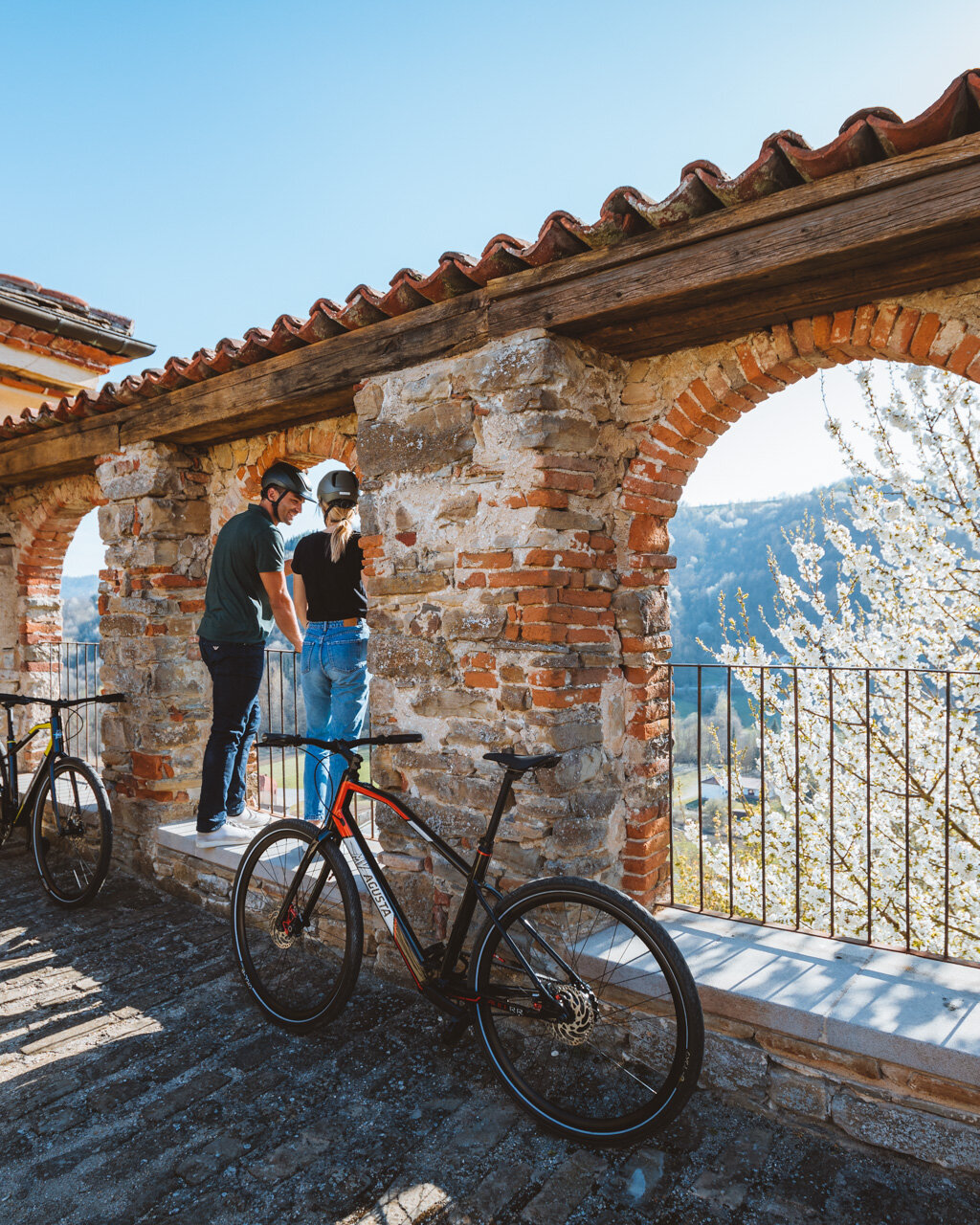You start from the large car park in Piazza Carlo Gancia, dedicated to the man who in 1865 set the guidelines of the "classic Italian method" for the production of Italy's first sparkling wine. Walk towards the low tower with a clock, follow the tree-lined avenue of Piazza Zoppa to the right and you will soon reach Piazza Cavour. Don't worry if you cannot distinguish the different squares: actually they all seem to be the continuation of each other, you only have to keep walking along the wide and enjoyable tree-lined avenue until it ends.
- suitable for: all ages
- suited to strollers (alternative road)
- elevation gain: +80 metres one-way
- distance: 2 km overall
- estimated time: 45 minutes overall
- route type: loop on asphalt, cobblestones
- starting altitude: 160 metres
- arrival altitude: 220 metres
- maximum altitude: 230 metres
- when: all year round
Now continue to the left along Via XX Settembre until you reach the lovely Piazza Amedeo d'Aosta, partially a pedestrian area. If you look up you can see your destination: the panoramic terrace is in fact just below the impressive Gancia Castle which completely overlooks Canelli from above. The original building was already there in the Middle Ages but it was destroyed in 1617. Once rebuilt it became known as Palazzo Scarampi Crivelli; nowadays it is completely renovated and is a residential villa.
You cross the entire square towards Casa Scarazzini, today a neoclassical building with a clock on the façade and which in the Middle Ages used to be home to the Town Hall and the Court. Who knows how to find the “Murales della famiglia affacciata” (the family at the window mural)? Just look up... Take Via G.B. Giuliani to the left ("Torre dei Contini" brown sign) and you will arrive in front of the palace of the Bosca Cellars, one of the Cattedrali Sotterranee (Underground Cathedrals), several kilometres of tunnels excavated in tuff between the 16th and 19th centuries where bottles of sparkling wine refine in silence before brightening up the tables throughout the world.
A little further to the left there is Palazzo Giuliani which houses the Enoteca Regionale and the Tourist Information offices. A little further to the right there is a second entrance to the Underground Cathedrals at the Cantina Contratto. But our route now turns right slightly uphill onto Via Rossini ("La Via degli Innamorati" brown sign), heading towards the clearly visible church of San Tommaso. Once at the church you should note how the theme of the vineyard is crucial to Canelli: there are in fact, along the streets, some examples of vines including the description of the types and specific characteristics. Next to San Tommaso you can find vine n. 10 of Arneis.
This seventeenth-century church is opposite the smaller church dedicated to the Annunziata, which dates back to the XVIII century. Right next to this church begins the so-called "Stërnìa" (cobbled path), now called Via Villanuova, a characteristic uphill cobbled road that climbs up with wide bends towards the Castle along panoramic views. Once you get to the small church of San Giuseppe, please pay attention and take the staircase to the left that leads directly to the panoramic terrace which offers a view of Canelli and Monferrato all the way to the Langhe (with prams you have to continue along the road instead).
After enjoying the view follow the uphill ramp along Via Costa Belvedere until it gets onto Via Villanuova. Turn left, again uphill, and you will arrive at one of the castle's entrances (private building, not open to the public). The walk continues straight ahead to the right, now downhill, through the richly decorated late 16th century Casa Prato to easily reach the baroque churches dedicated to San Leonardo and San Rocco, facing each other. The road crosses the two churches to get back onto the Stërnìa again, it continues to go downhill, always offering a panoramic view, and past other decorated buildings it joins the uphill road.
From this point you just follow the same route you took on your way up.
Notes
It is named "Via degli Innamorati" (Lovers’ road) after the characters designed by Raymond Peynet. The illustrator artist was in Canelli in 1983 to attend an exhibition and presentation of one of his films at Cantine Bocchino. He was deeply impressed by the peculiarity of the Stërnìa and drew his Lovers on a tile. Little by little, the ascent to the Stërnìa will be filled with works of art inspired by Peynet's world.
With prams you can continue along the street passing by the churches of San Leonardo and San Rocco (described route back).
There are many museums in Canelli: not to be missed the Bocchino Distillery Museum, which tells the story of the peasant civilization and distillation; the Museum of Vineyards, Wine and Old Farming Habits featuring tools related to the cultivation of vineyards and wine production in the nineteenth century.; the MUSA, South Asti area Multimedia Museum. Not included in our route, but part of the "Underground Cathedrals" system, the Cantine Coppo are also worth a visit.
About four kilometres south, towards Loazzolo, you can find the Big Bench of Canelli, one of the gigantic coloured benches inspired by artist Chris Bangle marking the Piedmont territory.
PLEASE NOTE: Responsibility for the maintenance and practicability of the various trails lies with the municipalities where the routes are located. The Tourist Board, therefore, cannot be held responsible for any inefficiencies, but is willingly available to collect your reports so that they can be forwarded to the authorities concerned.

